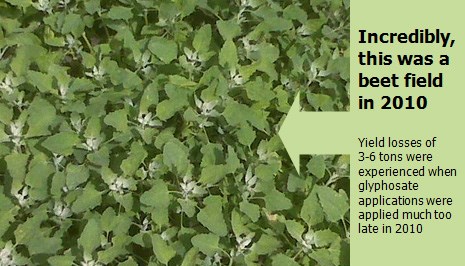554 - Maximizing Weed Control in Roundup Ready
Weed control has been made much more convenient and effective using herbicides containing glyphosate. Well over 50 herbicides containing glyphosate are registered for use in 2011. These products have 6 different levels of acid equivalent and vary widely in content of non-ionic surfactant. A brochure prepared with the assistance of Dr. Jeff Stachler, NDSU/UM Extension Sugarbeet Weed Specialist, summarizes the characteristics of each herbicide. It is available from your agriculturist.
Avoid Competition with Proper Timing
|
Weed Pressure |
Recommended Timing |
| Light | 2-4 Leaf Beets |
| Moderate | 2 Leaf Beets |
| Heavy | Cotyledon - 2 Leaf Beets |

Roundup Ready® Rate Selection
One rate of glyphosate does not fit all situations. Select rates based on a number of factors including the following considerations:
- Weed species present
- Environmental conditions
- Weed growth stage
- Possible weed tolerance or resistance to glyphosate
Maximize Glyphosate Rate Effectiveness
| Situation | Rate (4.5 lb/Gal. Acid Equiv) |
|---|---|
| Small weeds, very favorable environment | 22 oz/acre |
| Less favorable environment or larger weeds | 28 oz/acre |
| Unfavorable environment, very large weeds, hard to control weed species, suspected tolerance to Glyphosate | 32 oz/acre |
Timing the Second Application
- The label states it must be 10 days or more after the first application
- Determine if sufficient weeds have emerged
- Determine when weed size, species and density justify spraying
- Most second applications will be from 14 to 28 days after the initial application
Tips on Maximizing Weed Control With Roundup Ready®
- Best control is from 10 a.m. to 4 p.m.
- Add 8.5 to 17 lbs. of AMS per 100 gallons of spray solution
- Control is often better with lower volumes, about 10 gpa
- Rain within 6 hours may reduce weed control
- Avoid spraying with dust on plants
- Avoid spraying with dew on plants
- Cool weather slows activity and time needed for control
- Frost before application will reduce control
- Drought slows weed growth, reduces activity
- Air temperature over 85°F during application can reduce weed control
- Don't spray after sunset-weed control can be reduced
When to Tank Mix Stinger and Glyphosate
- For volunteer soybeans
- For glyphosate resistant Common Ragweed
- For Wild Buckwheat
- For Biennial Wormwood
Know Your Acid Equivalents
Over 50 Glyphosate formulations are available in 2011
Be sure you use correct rates.
Be Careful
Seed color alone is no guarantee a variety is conventional or Roundup Ready®. Ask your neighbor.
